Hi guys! I'm moving some content off of the main site and into the most relevant categories of the forum. This post was originally made on January 27th 2017:
Are electric bikes waterproof? Can an ebike be ridden in the rain and mud? How can I clean it safely afterwards? This is a series of questions lots of people ask when considering the purchase of an e-bike because well… it rains and puddles happen. Adding to this initial “dirtification” concern is the subsequent washing ritual. Okay, maybe the bike survived a rainy wet ride but now I want to wash it! is that okay? Can I spray it directly with the hose on full blast? What will happen to the electronics, motor, battery etc. if I try to clean my electric bicycle with water?
This is a sensitive topic because ebikes can cost a pretty penny, usually at least $1,500, and electricity and water usually don’t mix well. So, without creating a liability issue here for myself, I’m going to share what I’ve heard from electric bike shops along with some of my own hands-on experience and a bit of expert advice from a hard core e-mountain bike rider from the UK where it can get very wet and a bit of background on waterproof ratings… let’s start there.
and a bit of background on waterproof ratings… let’s start there.
In recent years some of the fancier electric bikes have designed motors, batteries and display units that specify an IP rating or “IP Code“. This stands for Ingress Protection which rates the degree of protection provided against intrusion (body parts such as hands and fingers), dust, accidental contact, and water by mechanical casings and electrical enclosures according to Wikipedia. Just the sort of rating you’d want for a product that’s being used in wet, dirty and abrasive conditions. The Specialized Turbo Levo is a good example of this, its battery pack is rated IP67 which would mean it is dust tight and may be submerged in water up to 1 meter. Crazy right? Not sure I’d actually try that… I got this interpretation by looking up the first and second digits of the IP Code independently in their little table. Again from Wikipedia: the first digit indicates the level of protection that the enclosure provides against access to hazardous parts (e.g., electrical conductors, moving parts) and the ingress of solid foreign objects. The second digit indicates the level of protection that the enclosure provides against harmful ingress of water.
So IP ratings are awesome but still fairly uncommon and in the case of the Turbo, only relate to specific components of the bike… the battery box itself, not the motor or display. So what about these other pieces and also the majority of less expensive electric bikes which don’t come with any sort of IP ratings? this is where we get subjective and where I’m going to reference what I have heard and seen from shops. Don’t blame me if you wash too vigorously or ride through a super deep puddle and the bike breaks, that’s up to you and the warranty provider and frankly, sometimes these products break due to wear and tear having nothing to do with cleaning. The best you can do is be somewhat educated and thoughtful in your approach
Story time! At one point, I actually did encounter damage from water on one of my electric bikes and this was in 2013 riding to and from work in Austin, Texas on a daily basis through some pretty heavy rain storms. The heavy downpours and tropical “rainy season” weather caused some water to leak into and condense on the LCD display unit… which still functioned, but did look a bit distorted. Around this same time, my twist throttle on said electric bike eventually failed which may have been due to water or could have also been due to me releasing it to spring back into the resting position with a “smack” sound. I have since become more thoughtful about how I use the throttle of similar ebikes. The end result of both issues was a trip to my local shop, Rocket Electrics, where they swapped out the twist throttle… Eventually the display dried out on its own and everything continued working fine. Did I ever clean this ebike? Very rarely, I occasionally used a damp rag to make the frame look better but this was a working bike, I didn’t care about the dirty tires, rims and squeaky disc brake rotors. Also, I didn’t have access to a hose and water because I was living in a run down apartment complex.
Looking back now, here’s what I might have done to clean the bike more thoroughly. The damp rag was right on but since bicycles use grease (and I didn’t want to completely re-grease the frame or cause wear on the paint) I didn’t use any soap… Some soap can actually be harsh on paint and stickers so there are specific spray-on cleaners that would work better. The downside of some of these cleaners are chemicals inside that can be bad for the environment and your lungs. Ultimately I found a few eco-cleaners including Pedro’s Green Fizz. This stuff gets the dirt off the frame without using high pressure water, soap or some random potentially toxic cleaner… All you need is a good rag and some time. You can actually spray the bike down completely, this cleaner is advertised as being safe for all frame materials and painted surfaces which is reassuring.
Ideally you’d have a bike stand to lift your bike which make cleaning the wheels easier. This one is semi-affordable but has a 55 lb suggested limit. Before lifting or moving the bike make sure you take off the battery to lighten your bike. If you don’t want or can’t afford a stand you can usually just flip the bike over onto its handlebars. WARNING! be careful not to break your shifters or LCD display panel when doing this. Some ebikes have removable displays which helps but given the extra wires and other sensitive parts that can be damaged when turned upside down it’s still a bit risky. Take care not to hurt yourself or your bike and consider using wooden blocks to elevate the mid-section of the bar as shown below. In the second picture you can see how the bike is suspended by straps in a garage so that the wheels are off the table for easy access and drivetrain movement. For people who can’t drill holes in their walls and don’t have a garage the stand or flip technique are probably the best bet.
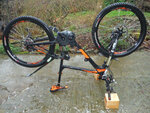

So once the bike is either lifted, flipped or leaning agains the kickstand or wall, you can spray the wheels and run a rag through the spokes. For those who want to get super deep into it and really clean parts like sprockets there’s a brush set available that will work better… And of course, there are also fancy rags to help you with those tight spots! In recent years micro-fiber rags have become less expensive and they work very well. They’re are designed to not leave scratches but if you get them very dirty and rub the dirt and grit around in you could still end up with some damage so be careful. Check out these ones which cost less than $10 for a pack then just rotate through and wash them all at the end to avoid the dirt scratching issue.
Once everything is clean on the bike, you might want to go back and re-grease the chain so that it runs smoothly and repels dirt. This is an entirely separate topic but the short story is that once again (perhaps more importantly this time), you lift the bike on a rack or flip it and then pedal while shifting through the gears and slowly dripping a de-greaser and then a lubricant onto the chain. As the degreaser and lubrication are applied you can wrap a rag around the chain gently to first clear debris and then clear extra lubrication so that the chain isn’t dripping wet. You can even get special chain cleaning devices like this to clear between the links. Most of the time I have paid to have this performed for me at a bicycle shop because I don’t have a stand, usually need a tuneup anyway and enjoy checking in and seeing new accessories etc. From what I hear, lots of people like the White Lightning chain lube (which contains wax, is said to be “self cleaning” and might last longer). There are different types of lube for different environments like dry desert, wet and humid forest etc. Another area to touch up are the electrical contacts and rust-prone areas of the bike using something like ACF-50 which is an anti-corrosion lubricant.
I welcome comments here and tips from riders who live in different environments (where they put salt on the roads or the ocean is nearby, where it rains a lot or is super dry etc.). I mostly wanted to create a high level guide to help you avoid pitfalls and understand how ebikes might be more sensitive but still very resilient to wet and dirty conditions. Most shops tell me that it’s fine to ride electric bikes in the rain, even heavy rain, and that the motors are well sealed along with the battery packs, displays, wires and connection points. The key is to avoid submersion and not spray high pressure at the bike which could enter into the bearings or frame. Most shops say you can rinse the bike with an outdoor hose or use a rag and some room temperature water but in my experience the bike cleaner works best and avoids water buildup… it allows you to use less force when cleaning which seems to be the major cause of damage. For those who are deeply concerned about rain, I have heard that covering the display with a clear plastic sack and using a rubber band can add protection but the downside is that moisture can get trapped inside the bag and evaporate and re-condense inside the display which could be very bad… If you go the bag route, just be careful to either fully seal it then remove it as soon as you get home (or better yet, remove the display entirely if it has a quick-release) and let it dry out. Some people use bags to protect the sensitive bits when hosing their bikes down AFTER getting them dirty, my friend Eddie Jefferies from the UK does this and actually wrote an amazing deep-dive guide here for his Bosch powered electric bike. Note that Eddie is extremely hard on his bikes, taking them through deep mud on long journeys and even races that can be trying on hardware… these things are not invincible, but I’m still impressed with what they can handle. If his bike can look like this on a regular basis, you should feel secure riding in the rain and through puddles, especially with the nicer systems. Shown below are shots of Bosch Centerdrive powered ebikes from KTM and a Dapu hub motor powered electric bike from Easy Motion.
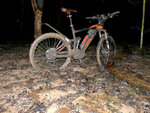
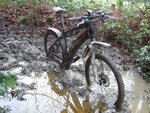
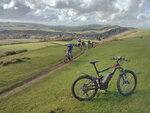
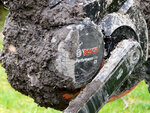
Ebikes use some of the same technology as smart phones which are now offered as “water resistant” and seem to hold up well. Damage to the casing, high pressure and full submersion will take a tole (with phones and ebikes) but you shouldn’t be afraid to use your bike in the rain or other inclement weather. I rode my electric bike daily for over a year (before selling it used) in all sorts of rainy and wet conditions in Austin and only tuned it up a couple of times (at the shop) with the occasional damp rag wipe down in between and it looked pretty good most of the time and always operated fine. I could tell that it was smoother and faster after tuneups but even on the dirtiest, worst days I still got to work and had a good time. With the basic spray cleaners and a microfiber cloth you’re 80% there and with a bike stand, chain cleaner and some brushes you’re going to be great. I still go to my local shop for tune ups and usually they will clean the chain as part of that experience. One additional tip that has been shared about cleaning bicycles is to use car wax afterwards to protect from UV and create a nice polish. Many synthetic spray-on waxes could work great for this but don’t get things so slick that you have issues holding on! Keep in mind too that there are now many mobile bike shops that will come to you for help with cleaning if you live in a small space and don’t have a stand
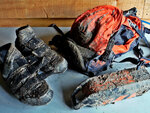
This article was NOT sponsored by Bosch, Dapu, KTM, Easy Motion or any other ebike brand or cleaning supply company, it’s just my thoughts. Again, feel free to add your own in the comments even if you do work for a company, just be transparent about it. To see more of Eddie’s great pictures or connect with him directly check out https://www.facebook.com/edwardpeterjefferies/ and https://www.instagram.com/eddiejefferies/ all images were used with permission. I noticed that some of accessories Eddie likes to add to his bike when riding to keep his person mud-free are plastic fenders like these.
Are electric bikes waterproof? Can an ebike be ridden in the rain and mud? How can I clean it safely afterwards? This is a series of questions lots of people ask when considering the purchase of an e-bike because well… it rains and puddles happen. Adding to this initial “dirtification” concern is the subsequent washing ritual. Okay, maybe the bike survived a rainy wet ride but now I want to wash it! is that okay? Can I spray it directly with the hose on full blast? What will happen to the electronics, motor, battery etc. if I try to clean my electric bicycle with water?
This is a sensitive topic because ebikes can cost a pretty penny, usually at least $1,500, and electricity and water usually don’t mix well. So, without creating a liability issue here for myself, I’m going to share what I’ve heard from electric bike shops along with some of my own hands-on experience and a bit of expert advice from a hard core e-mountain bike rider from the UK where it can get very wet
In recent years some of the fancier electric bikes have designed motors, batteries and display units that specify an IP rating or “IP Code“. This stands for Ingress Protection which rates the degree of protection provided against intrusion (body parts such as hands and fingers), dust, accidental contact, and water by mechanical casings and electrical enclosures according to Wikipedia. Just the sort of rating you’d want for a product that’s being used in wet, dirty and abrasive conditions. The Specialized Turbo Levo is a good example of this, its battery pack is rated IP67 which would mean it is dust tight and may be submerged in water up to 1 meter. Crazy right? Not sure I’d actually try that… I got this interpretation by looking up the first and second digits of the IP Code independently in their little table. Again from Wikipedia: the first digit indicates the level of protection that the enclosure provides against access to hazardous parts (e.g., electrical conductors, moving parts) and the ingress of solid foreign objects. The second digit indicates the level of protection that the enclosure provides against harmful ingress of water.
So IP ratings are awesome but still fairly uncommon and in the case of the Turbo, only relate to specific components of the bike… the battery box itself, not the motor or display. So what about these other pieces and also the majority of less expensive electric bikes which don’t come with any sort of IP ratings? this is where we get subjective and where I’m going to reference what I have heard and seen from shops. Don’t blame me if you wash too vigorously or ride through a super deep puddle and the bike breaks, that’s up to you and the warranty provider and frankly, sometimes these products break due to wear and tear having nothing to do with cleaning. The best you can do is be somewhat educated and thoughtful in your approach
Story time! At one point, I actually did encounter damage from water on one of my electric bikes and this was in 2013 riding to and from work in Austin, Texas on a daily basis through some pretty heavy rain storms. The heavy downpours and tropical “rainy season” weather caused some water to leak into and condense on the LCD display unit… which still functioned, but did look a bit distorted. Around this same time, my twist throttle on said electric bike eventually failed which may have been due to water or could have also been due to me releasing it to spring back into the resting position with a “smack” sound. I have since become more thoughtful about how I use the throttle of similar ebikes. The end result of both issues was a trip to my local shop, Rocket Electrics, where they swapped out the twist throttle… Eventually the display dried out on its own and everything continued working fine. Did I ever clean this ebike? Very rarely, I occasionally used a damp rag to make the frame look better but this was a working bike, I didn’t care about the dirty tires, rims and squeaky disc brake rotors. Also, I didn’t have access to a hose and water because I was living in a run down apartment complex.
Looking back now, here’s what I might have done to clean the bike more thoroughly. The damp rag was right on but since bicycles use grease (and I didn’t want to completely re-grease the frame or cause wear on the paint) I didn’t use any soap… Some soap can actually be harsh on paint and stickers so there are specific spray-on cleaners that would work better. The downside of some of these cleaners are chemicals inside that can be bad for the environment and your lungs. Ultimately I found a few eco-cleaners including Pedro’s Green Fizz. This stuff gets the dirt off the frame without using high pressure water, soap or some random potentially toxic cleaner… All you need is a good rag and some time. You can actually spray the bike down completely, this cleaner is advertised as being safe for all frame materials and painted surfaces which is reassuring.
Ideally you’d have a bike stand to lift your bike which make cleaning the wheels easier. This one is semi-affordable but has a 55 lb suggested limit. Before lifting or moving the bike make sure you take off the battery to lighten your bike. If you don’t want or can’t afford a stand you can usually just flip the bike over onto its handlebars. WARNING! be careful not to break your shifters or LCD display panel when doing this. Some ebikes have removable displays which helps but given the extra wires and other sensitive parts that can be damaged when turned upside down it’s still a bit risky. Take care not to hurt yourself or your bike and consider using wooden blocks to elevate the mid-section of the bar as shown below. In the second picture you can see how the bike is suspended by straps in a garage so that the wheels are off the table for easy access and drivetrain movement. For people who can’t drill holes in their walls and don’t have a garage the stand or flip technique are probably the best bet.


So once the bike is either lifted, flipped or leaning agains the kickstand or wall, you can spray the wheels and run a rag through the spokes. For those who want to get super deep into it and really clean parts like sprockets there’s a brush set available that will work better… And of course, there are also fancy rags to help you with those tight spots! In recent years micro-fiber rags have become less expensive and they work very well. They’re are designed to not leave scratches but if you get them very dirty and rub the dirt and grit around in you could still end up with some damage so be careful. Check out these ones which cost less than $10 for a pack then just rotate through and wash them all at the end to avoid the dirt scratching issue.
Once everything is clean on the bike, you might want to go back and re-grease the chain so that it runs smoothly and repels dirt. This is an entirely separate topic but the short story is that once again (perhaps more importantly this time), you lift the bike on a rack or flip it and then pedal while shifting through the gears and slowly dripping a de-greaser and then a lubricant onto the chain. As the degreaser and lubrication are applied you can wrap a rag around the chain gently to first clear debris and then clear extra lubrication so that the chain isn’t dripping wet. You can even get special chain cleaning devices like this to clear between the links. Most of the time I have paid to have this performed for me at a bicycle shop because I don’t have a stand, usually need a tuneup anyway and enjoy checking in and seeing new accessories etc. From what I hear, lots of people like the White Lightning chain lube (which contains wax, is said to be “self cleaning” and might last longer). There are different types of lube for different environments like dry desert, wet and humid forest etc. Another area to touch up are the electrical contacts and rust-prone areas of the bike using something like ACF-50 which is an anti-corrosion lubricant.
I welcome comments here and tips from riders who live in different environments (where they put salt on the roads or the ocean is nearby, where it rains a lot or is super dry etc.). I mostly wanted to create a high level guide to help you avoid pitfalls and understand how ebikes might be more sensitive but still very resilient to wet and dirty conditions. Most shops tell me that it’s fine to ride electric bikes in the rain, even heavy rain, and that the motors are well sealed along with the battery packs, displays, wires and connection points. The key is to avoid submersion and not spray high pressure at the bike which could enter into the bearings or frame. Most shops say you can rinse the bike with an outdoor hose or use a rag and some room temperature water but in my experience the bike cleaner works best and avoids water buildup… it allows you to use less force when cleaning which seems to be the major cause of damage. For those who are deeply concerned about rain, I have heard that covering the display with a clear plastic sack and using a rubber band can add protection but the downside is that moisture can get trapped inside the bag and evaporate and re-condense inside the display which could be very bad… If you go the bag route, just be careful to either fully seal it then remove it as soon as you get home (or better yet, remove the display entirely if it has a quick-release) and let it dry out. Some people use bags to protect the sensitive bits when hosing their bikes down AFTER getting them dirty, my friend Eddie Jefferies from the UK does this and actually wrote an amazing deep-dive guide here for his Bosch powered electric bike. Note that Eddie is extremely hard on his bikes, taking them through deep mud on long journeys and even races that can be trying on hardware… these things are not invincible, but I’m still impressed with what they can handle. If his bike can look like this on a regular basis, you should feel secure riding in the rain and through puddles, especially with the nicer systems. Shown below are shots of Bosch Centerdrive powered ebikes from KTM and a Dapu hub motor powered electric bike from Easy Motion.




Ebikes use some of the same technology as smart phones which are now offered as “water resistant” and seem to hold up well. Damage to the casing, high pressure and full submersion will take a tole (with phones and ebikes) but you shouldn’t be afraid to use your bike in the rain or other inclement weather. I rode my electric bike daily for over a year (before selling it used) in all sorts of rainy and wet conditions in Austin and only tuned it up a couple of times (at the shop) with the occasional damp rag wipe down in between and it looked pretty good most of the time and always operated fine. I could tell that it was smoother and faster after tuneups but even on the dirtiest, worst days I still got to work and had a good time. With the basic spray cleaners and a microfiber cloth you’re 80% there and with a bike stand, chain cleaner and some brushes you’re going to be great. I still go to my local shop for tune ups and usually they will clean the chain as part of that experience. One additional tip that has been shared about cleaning bicycles is to use car wax afterwards to protect from UV and create a nice polish. Many synthetic spray-on waxes could work great for this but don’t get things so slick that you have issues holding on! Keep in mind too that there are now many mobile bike shops that will come to you for help with cleaning if you live in a small space and don’t have a stand

This article was NOT sponsored by Bosch, Dapu, KTM, Easy Motion or any other ebike brand or cleaning supply company, it’s just my thoughts. Again, feel free to add your own in the comments even if you do work for a company, just be transparent about it. To see more of Eddie’s great pictures or connect with him directly check out https://www.facebook.com/edwardpeterjefferies/ and https://www.instagram.com/eddiejefferies/ all images were used with permission. I noticed that some of accessories Eddie likes to add to his bike when riding to keep his person mud-free are plastic fenders like these.
Last edited:

